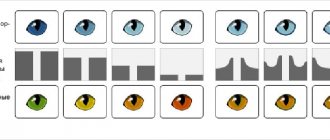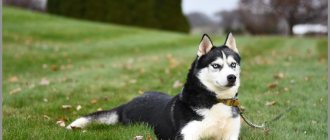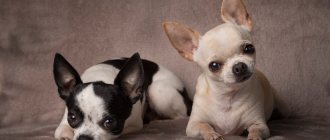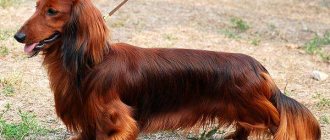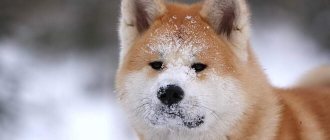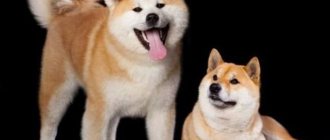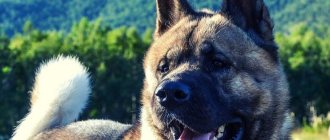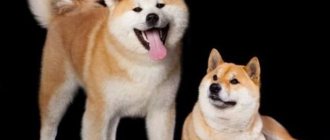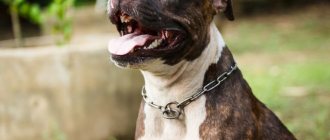The Akita Inu breed is known to us thanks to the famous Hachiko. In his historical homeland, Japan, a monument was erected to him. This place serves for meetings of lovers, as a symbol of selfless love and devotion.
But this breed is not only attractive for its touching affection for its owner. Her external data is no less worthy of attention. The noble appearance of the dog with wise eyes, a fluffy coat and funny triangular ears captivates future Akita owners at first sight.
A little history
Akita, Inu is ranked among the fourteen oldest dog species in the world. Scientists made this decision based on DNA tests, a thorough study of the ancestry of our heroes, and also thanks to the rock paintings found. Our heroes are unofficially called the Japanese Laika. Firstly, because they are from Japan, and secondly, because they really have a lot in common, although this species belongs to the Spitz group.
Until the seventeenth century, the Japanese husky served ordinary people and helped them in hunting, guarded the house, herded livestock and even took part in dog fights. It is worth noting that in those days the breed was much smaller than today. In order for the Akita to look impressive as a fighter, and for the spectacle to become even more entertaining, they began to crossbreed it with mastiffs. The result was a variety called "matagi".
In the eighteenth century, the Akita became a privileged dog , and only high-ranking and noble people were allowed to keep it. And the point is not even that the Akita’s appearance can be considered the standard of canine beauty, but that they are talented and naturally gifted hunters. In addition, they are smart enough to be easily trained and work harmoniously as a team with their owner, lying in wait for prey. The status of the Akita rose to the imperial level.
During the Second World War, the breed practically disappeared due to their conscription to the front. Under pain of execution, many owners hid their pets and thereby gave cynologists the opportunity in the post-war period to restore an almost extinct species. During the same period, experiments on crossing with the German Shepherd took place. A new variety appears - the shepherd dog.
American soldiers, returning home from the war, took incredibly cute puppies home with them. Subsequently, American cynologists will develop a new variety called “American Akita” . It is larger, and it is this species that is most common in Russia. According to existing criteria, the maximum height of a pet does not exceed seventy centimeters.
To read: Differences and similarities between husky and malamute in character and external data
Animal character
Akitas are amazing dogs. Their restraint and unobtrusiveness is simply amazing. They are very attached to their owners, and will faithfully and truly be ready to protect and protect loved ones. But, at the same time, they will never demand attention, pester or impose themselves.
But it is worth understanding that raising and training animals is not easy. They have a strong, strong-willed character and complex disposition. To say that dogs have their own minds is not true. But if they feel weak, they will definitely try to take a leading place in the family. Therefore, if you are not ready to pay due attention, and your rhythm of life is similar to a chaotic schedule consisting of bustle and to-dos, it is best to refuse such a pet. But, if time allows, and the desire is irresistible, then feel free to get down to business. Before choosing a puppy, we advise you to familiarize yourself with all acceptable and possible colors. We are sure that the choice will be quite difficult. Akita Inu has more than a variety of colors!
Approved colors
All of the above are united by the fact that no matter what continent the animal lives on and what size it has, there are only four acceptable colors according to the World Canine Federation:
- brindle,
- Sesame,
- Snow-white,
- Red-fawn.
But not everything is so simple! There are three more versions of the standard and they are all presented by different organizations. AKIHO allows the presence of the following colors in the color:
- white,
- spotted,
- black,
- ginger,
- sesame,
- brindle.
NIPPO accepts all of the options listed above, but excludes spotted Akita Inus. AKIKIO allows various options for the following colors:
- Black,
- White,
- brindle,
- Ginger,
- Sesame.
Each author of the listed standards has his own vision of the beauty of the Japanese husky, and he substantiates it with arguments. The difficulty of determining one color or another is also due to the fact that the colors of dogs can change with age. Only the snow-white fur remains unchanged.
What do the puppies look like?
It's impossible not to fall in love with an Akita Inu puppy at first sight. They look like little teddy bears - the dream of every child and adult.
Puppies born from red parents 2-3 weeks after birth can have all possible shades of sand color - from completely gray to intensely red. Over time, the color changes into different shades of red, from fawn to red. There may be black tips of hair on the back and at the end of the tail. These hairs usually shed during the first adult moult.
Brindle puppies do not change much the color they are born with. Whites may change color slightly - a few cream spots may appear on the tips of the ears, and cream may appear on the back.
Initially, puppies' ears hang down; they stand up at about 2-4 months. If the ears do not stand up before the teeth change, the process may be delayed, since hardening of the ear cartilage requires calcium, which goes to the teeth. In this case, the ears may rise asymmetrically, one may be ahead of the other. When they stand up completely, symmetry is restored.
Puppies' tails resemble a small donut. The paws are soft and fluffy. The general build of the puppy is plump and round. Gradually the dog will stretch out and become slimmer.
Akita Inu white
This suit is today recognized as the rarest in Russia, but often found in Japan. And it appeared relatively recently, only in the first half of the twentieth century. An important condition is the absence of any, even the tiniest spots, and also the lips and tip of the nose are visually outlined; they should be as dark and clear as possible.
A light nose is acceptable provided that the outline of the lips and around the eyes is contrastingly dark. The purity of white also plays a big role in the evaluation of a pet at shows. Acceptable, but still a drawback is the presence of a yellow or gray tint. But a light touch of blue will only add points and is considered ideal.
Nutrition
You can feed your dog properly selected dry food or natural food.
In the second case, the basis of the diet should be lean meat, some vegetables, and cottage cheese. A couple of times a week – a raw egg.
Be sure to include vitamin complexes and supplements that improve the condition of the coat during the molting period. You should not limit your pet’s access to fresh water or give table scraps.
Black
In fact, it is very rare . Most often, this color, when viewed more carefully by a professional eye, is classified as black sesame or brindle without a clear stripe pattern.
Please note that three out of four existing standards accept this color, since since ancient times it has been customary to depict national pride in black and white.
Considering the age of the breed, it can be assumed that many of the drawings were created during that period of the historical development of mankind, when multi-colored drawings were impossible.
Breed Features
Dogs of this breed are very calm. Their training should be accompanied by affection and firmness. The main thing in raising a puppy is to let him understand that his owner is also his best friend. It is worth understanding that this dog is very active and needs long walks.
The breed is not fussy when it comes to grooming and eats everything. But you should monitor its weight, since without physical activity the dog is prone to obesity. This breed is considered very healthy and rarely gets sick, but there are still some diseases that can kill a dog. To prevent this from happening, you should definitely take your dog to the veterinarian.
When choosing a dog for your home, you should definitely pay attention to the description of the Akita Inu. A four-legged animal can become not only a friend, but also a good helper. Dogs of this breed make excellent nannies for children.
Brindle color
The Japanese husky with a tiger skin is still exotic for Russia, but in the historical homeland of the animal it is now the most popular. There are several varieties of this suit:
- Blue,
- White (with very light stripes),
- Black (also divided by degree of saturation),
- Redhead.
For a long time there was debate about whether stripes on the head were acceptable, and, ultimately, they came to the conclusion that it was better without them.
To read: Charming white dwarf Pomeranian spitz: recommendations for caring for your pet
In the red version, paler shades are appreciated, while deep red is undesirable. The most prominent and valued judges at international exhibitions are black and salt and pepper.
Red and sesame
This classification includes wool from pale beige to fiery red. The undercoat can also play an important role. For example, a light undercoat visually lightens the guard hair, while against a dark background the color of the coat will look more saturated.
The presence of a “mask” on the face is a serious defect for the Japanese variety, but it is almost always present and is considered the norm in the American type.
The sesame variant is the rarest today and although it is still listed in the standards, it may soon disappear completely, since it does not take part in selection. Until the fifties of the last century, it was a classic - a red fur coat with a dark belt on the back. Now in Japan, individuals with sesame coloring are not popular.
Popular types
Akita Inu is usually divided into types according to color. But there are also two large varieties - Japanese and American.
Japanese
The breed itself originated in Japan . Initially, two Japanese species - the red and brindle Akita Inu - became widespread in their homeland, and then throughout the world.
Brindle color can be light, black, blue or red. The Red Akita is primarily tan in color with white patches on the face, chest and paws, and belly.
Sometimes in the litter of Japanese dogs there were individuals with a pure white color , this served as the beginning for the breeding of a new species - a white Akita with a black nose.
American
Previously, the species was called the large Japanese dog. This species, larger and stockier than its Japanese counterparts, appeared thanks to the work of American breeders based on a breed brought to the United States after the war.
Dogs of this species are distinguished by intelligence, cunning and independent character. This variety of Akita is very popular in Russia, as they are ideal protectors and guardians.
The American species
is distinguished by the presence of “plush” fur and a characteristic dark color on the face. Moreover, the overall color of the coat allows for any color variations, including white, fawn-white, red and brindle. American Akitas can even be piebald, that is, spotted (pinto) - with or without a mask.
